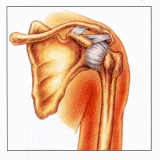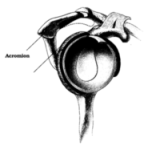


Bristol Knee Clinic

| + home | |
| + news | |
| + research | |
| + patient information | |
| + the clinic | |
| + the surgeon | |
| + sport physiotherapy | |
| + sports advice | |
| + medico legal | |
| + products | |
| + resources | |
| + contact | |
| + maps | |
| + directions | |
| + site map |
The Bristol Knee Clinic |
Arthroscopy Of The Shoulder - Indications / Contra-indications
Anatomy / Ailment Detail
Shoulder problems are increasingly recognized as a significant and increasing problem. They occur in competitive and recreational sports but also as a degenerative or ageing problem from working activities and laboring. Problems may even arise in normal daily activities such as cleaning, housework, driving, DIY or gardening. Shoulder problems may also arise acutely following road traffic accidents, falls onto the arm or other sudden forced movements of the arm.

Understanding the anatomy of the shoulder is an important aspect to understanding the problems which may arise. The upper arm or humerus bone has a rounder head (the head of the humerus) which articulates with the small cup of the shoulder blade or scapula bone. The articulating cup of the shoulder joint is quite small which allows for the wide range of motion possible at the shoulder joint. The shoulder is supported and stabilized by an extension of bone from the scapula which lies above the shoulder and forms the covering acromial arch or point of the shoulder. The socket is deepened further by arching ligaments between the acromium and the corocoid process of the front of the scapula. The strong muscles of the back (latissimus Dorsi), the front of the chest wall (pectoral muscles) and around the shoulder (deltoid muscle, and subscapularis muscle) help to stabilize the shoulder joint as it moves.
The image above shows an anatomic diagram of the anterior aspect of the left shoulder joint. The humerus of upper arm articulates and forms a joint with the glenoid part of the scapula or shoulder blade. The clavicle or collar bone also forms a joint with the acromium part of the scapula.

As a result of the anatomy the shoulder joint is prone to instability or dislocation with trauma. The muscle tendons around the top of the shoulder join together with the subscapular tendon to form the Rotator Cuff. This is the expanse of tendon which lies above the humerus and beneath the acromium bone at the top of the shoulder. On a chronic and long term basis the tendon of the subscapularis muscle can become worn, degenerate, inflamed or damaged as it passes over the head of the scapula but beneath the arch of the acromium bone. This produces the condition of Rotator Cuff Tendonitis or Sub-acromial impingement.
Who Needs it / Who Doesn't
In Rotator Cuff Tendonitis or Sub-acromial impingement the symptoms complained of are usually pain, stiffness and weakness:
Pain
The pain from rotator cuff tendonitis usually occurs when the inflamed tendon is trapped under the covering arch of the
acromium bone which forms the bone on top or point of the shoulder. This occurs when the arm is raised up above the head or
in twisting movements of the arm across the cheat or up behind the back. This is often noticed when driving, reaching, carrying
shopping or washing and toileting. The sudden pain is felt on the lateral or outer side of the shoulder and upper arm. The pain
may also occur at night when lying on that side.
Stiffness
Rotator cuff tendonitis does not usually cause primarily stiffness. The limitation of movement at the limits of motion are
restricted by pain and the inflamed tendon. The condition can usually be differentiated from "Frozen Shoulder" which is
characterised by a global stiffness and restricted range of motion in the shoulder which tends to be less painful, chronic
rather than acute and of slow and gradual onset. Rotator Cuff Tendonitis commonly results in a restriction of movement in
respect of raising the hand above the head, placing it behind the back or reaching across the chest.
Weakness
The shoulder may feel weak from any condition affecting the shoulder. Rotator Cuff tendonitis often results in weakness in
the positions where pain is precipitated and in those where the shoulder feels stiff. Thus weakness in lifting, carry shopping,
reaching out, washing one's hair or in toileting are common features of the condition.
How to arrange an appointment with Mr. Johnson
Your first appointment is usually arranged with Mr Johnson at the Bristol Nuffield Hospital at St Mary's. It is a modern well-equipped hospital with 36 private bedrooms and two operating theatres, and offers a full range of services.
+ How to arrange your first appointment
< BACK to Introduction | NEXT: Non-operative Treatment >
Related Links..
+ Arthroscopy Of The Shoulder - see all links
+ Patient Information Home
+ See the clinic
+ More about Mr Johnson
+ top
© The Bristol Orthopaedics and Sports Injuries Clinic 2003. The Bristol Knee Clinic is a trading name of the Bristol Orthopaedic Clinic Ltd. privacy / copyright | contact | Powered By Create Medical



